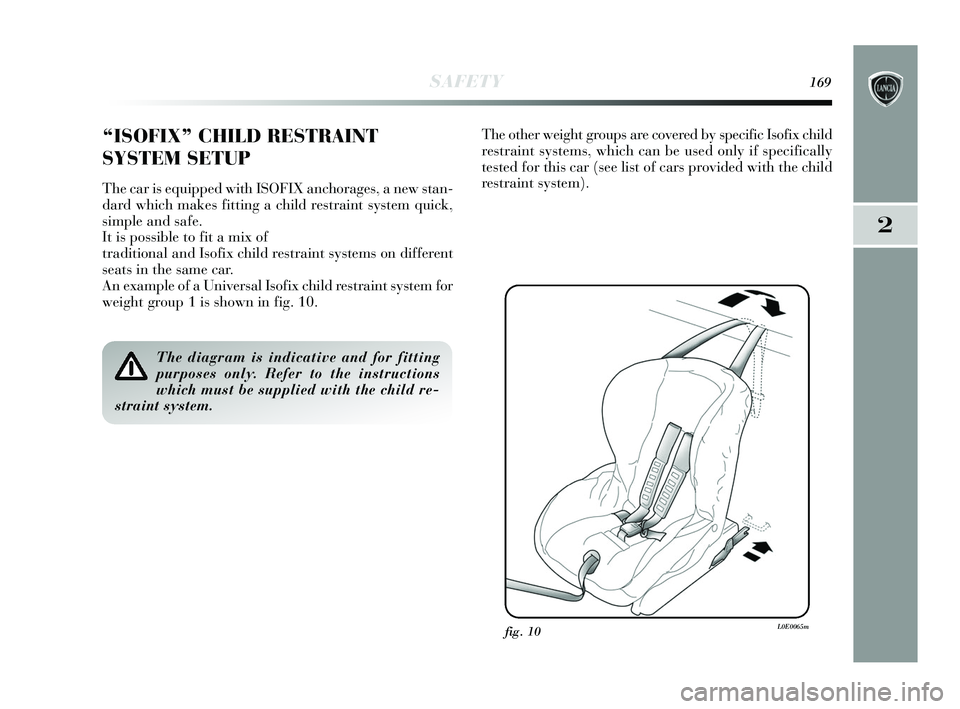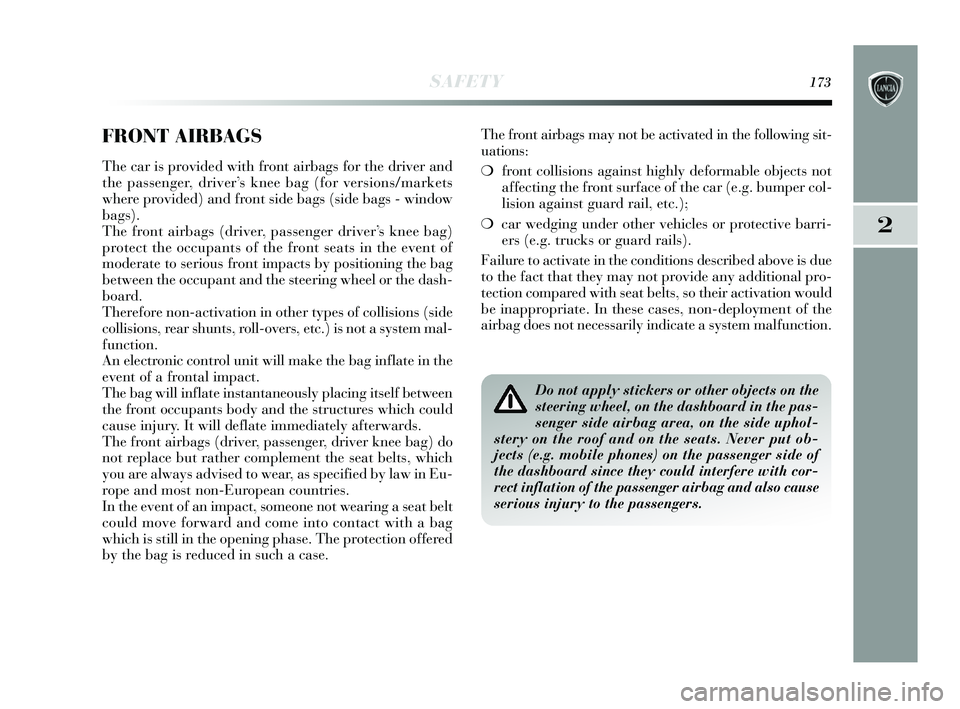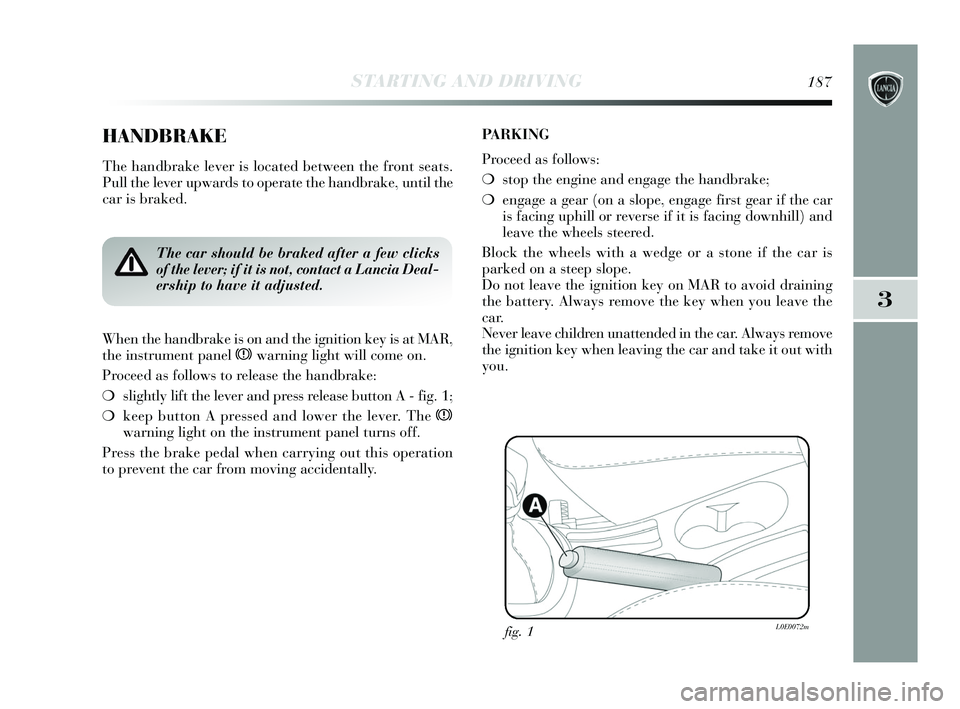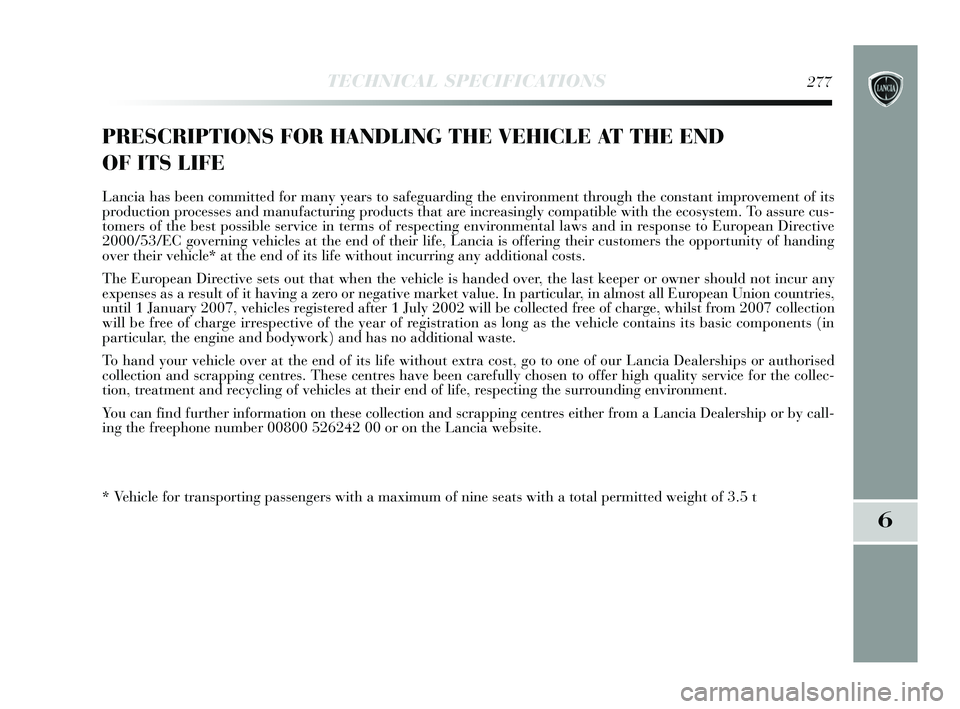seats Lancia Delta 2015 Owner handbook (in English)
[x] Cancel search | Manufacturer: LANCIA, Model Year: 2015, Model line: Delta, Model: Lancia Delta 2015Pages: 291, PDF Size: 6.74 MB
Page 171 of 291

SAFETY169
2
“ISOFIX” CHILD RESTRAINT
SYSTEM SETUP
The car is equipped with ISOFIX anchorages, a new stan-
dard which makes fitting a child restraint system quick,
simple and safe.
It is possible to fit a mix of
traditional and Isofix child restraint systems on different
seats in the same car.
An example of a Universal Isofix child restraint system for
weight group 1 is shown in fig. 10.The other weight groups are covered by specific Isofix child
restraint systems, which can be used only if specifically
tested for this car (see list of cars provided with the child
restraint system).
fig. 10L0E0065m
The diagram is indicative and for fitting
purposes only. Refer to the instructions
which must be supplied with the child re-
straint system.
155-182 Delta GB 1ed 26/08/13 11.29 Pagina 169
Page 173 of 291

SAFETY171
2
PASSENGER SEAT COMPLIANCE WITH REGULATIONS ON ISOFIX CHILD RESTRAINT SYSTEM USE
The table below shows the various installation possibilities for Isofix \
child restraint systems on seats fitted with Isofix
attachments in accordance with European standard ECE 16.
IL: suitable for ISOFIX child restraint systems of the “Specific for the vehicle”, “Restricted\
” or “Semiuniversal” categories, approved
for this type of vehicle.
IUF: suitable for forward facing Isofix child restraint systems in the Universal category and approved for use in the weight gr oup.
Weight groupRestraint systemIsofix sizeRear side
orientation classpassengers
Portable cradle SideF-GIL
Group 0 up to 10 kg Rear facingEIL
Rear facing EIL
Group 0+ up to 13 kg Rear facingDIL
Rear facing CIL
Rear facing DIL
Rear facing CIL
Group 1 from 9 up to 18 kg Forward facingBIUF
Forward facing B1IUF
Forward facing AIUF
155-182 Delta GB 1ed 26/08/13 11.29 Pagina 171
Page 174 of 291

172SAFETY
Main instructions for carrying children safely:
❍Install the child restraint systems on the rear seat,
which is the most protected position in the event of
an accident.
❍ Keep children in rear facing restraint systems for as
long as possible, until 3–4 years old if possible.
❍ Should a rear facing child restraint system be installed
on the rear seats, it is advisable to position it as far for-
ward as the position of the front seat allows.
❍ If the front passenger’s airbag is deactivated always
check that the dedicated warning light is permanent-
ly switched on on the instrument panel to make sure
that it has actually been deactivated.
❍ Carefully follow the instructions supplied with the child
restraint system itself. Keep the instructions in the car
along with the other documents and this handbook.
Do not use second-hand child restraint systems with-
out instructions. ❍
Only one child is to be strapped to each retaining sys-
tem; never use it to transport two children at once.
❍ Always check that the seat belts do not interfere with
the child’s throat.
❍ Always check that the seat belt is well fastened by
pulling on it.
❍ While travelling, do not let the child sit incorrectly or
unfasten the belts.
❍ Never allow a child to put the belt’s diagonal section
under an arm or behind their back.
❍ Never carry children on your lap, even newborns. No-
one can restrain a child in the event of an accident.
❍ In the event of an accident, replace the child restraint
system with a new one.
Fit the child restraint system according to the
instructions, which must be included.
155-182 Delta GB 1ed 26/08/13 11.29 Pagina 172
Page 175 of 291

SAFETY173
2
FRONT AIRBAGS
The car is provided with front airbags for the driver and
the passenger, driver’s knee bag (for versions/markets
where provided) and front side bags (side bags - window
bags).
The front airbags (driver, passenger driver’s knee bag)
protect the occupants of the front seats in the event of
moderate to serious front impacts by positioning the bag
between the occupant and the steering wheel or the dash-
board.
Therefore non-activation in other types of collisions (side
collisions, rear shunts, roll-overs, etc.) is not a system mal-
function.
An electronic control unit will make the bag inflate in the
event of a frontal impact.
The bag will inflate instantaneously placing itself between
the front occupants body and the structures which could
cause injury. It will deflate immediately afterwards.
The front airbags (driver, passenger, driver knee bag) do
not replace but rather complement the seat belts, which
you are always advised to wear, as specified by law in Eu-
rope and most non-European countries.
In the event of an impact, someone not wearing a seat belt
could move forward and come into contact with a bag
which is still in the opening phase. The protection offered
by the bag is reduced in such a case.The front airbags may not be activated in the following sit-
uations:
❍
front collisions against highly deformable objects not
affecting the front surface of the car (e.g. bumper col-
lision against guard rail, etc.);
❍ car wedging under other vehicles or protective barri-
ers (e.g. trucks or guard rails).
Failure to activate in the conditions described above is due
to the fact that they may not provide any additional pro-
tection compared with seat belts, so their activation would
be inappropriate. In these cases, non-deployment of the
airbag does not necessarily indicate a system malfunction.
Do not apply stickers or other objects on the
steering wheel, on the dashboard in the pas-
senger side airbag area, on the side uphol-
stery on the roof and on the seats. Never put ob-
jects (e.g. mobile phones) on the passenger side of
the dashboard since they could interfere with cor-
rect inflation of the passenger airbag and also cause
serious injury to the passengers.
155-182 Delta GB 1ed 26/08/13 11.29 Pagina 173
Page 183 of 291

SAFETY181
2
With ignition key inserted, at MAR, even if
the engine is off, the airbags can activate al-
so with the car stopped, if it is hit by anoth-
er vehicle. Therefore, even if the car is stationary,
when an active passenger airbag is fitted, DO NOT
install rear facing child restraint systems on the
front passenger seat. Deployment of the airbag fol-
lowing an impact could cause fatal injuries to the
child. Therefore, always deactivate the passenger
airbag when a rear facing child restraint system
is installed on the front passenger seat. The front
passenger seat must also be positioned back as far
as possible in order to avoid the child restraint sys-
tem from coming into contact with the dashboard.
Immediately reactivate the passenger airbag as soon
as the child restraint system has been removed. Al-
so remember that, if the key is turned to STOP, none
of the safety devices (airbags or pretensioners) will
be deployed in the event of collision. Non-deploy-
ment in such cases does not indicate a system mal-
function.When the ignition key is turned to MAR, the
“ warning light turns on and blinks for a few
seconds to remind you that the passenger
airbag will activate in the event of a collision. Then
it should turn off.
Do not wash the seats with water or pres-
surised steam (by hand or at automatic car
seat washing stations).
The front airbags deploy in the event of more
severe collisions than those required for de-
ploying the pretensioners. For impacts in the
range between the two activation thresholds, pre-
tensioner activation alone is normal.
Do not hook rigid objects to clothes hangers
and support handles.
The airbag does not replace seat belts; it in-
creases their effectiveness. Furthermore, since
front airbags are not deployed in low speed
collisions, side collisions, rear-end shunts or roll-
overs, the passengers are only protected by the seat
belts which must be fastened at all times.
155-182 Delta GB 1ed 26/08/13 11.29 Pagina 181
Page 189 of 291

STARTING AND DRIVING187
3
HANDBRAKE
The handbrake lever is located between the front seats.
Pull the lever upwards to operate the handbrake, until the
car is braked.
The car should be braked after a few clicks
of the lever; if it is not, contact a Lancia Deal-
ership to have it adjusted.
When the handbrake is on and the ignition key is at MAR,
the instrument panel xwarning light will come on.
Proceed as follows to release the handbrake:
❍ slightly lift the lever and press release button A - fig. 1;
❍ keep button A pressed and lower the lever. The x
warning light on the instrument panel turns off.
Press the brake pedal when carrying out this operation
to prevent the car from moving accidentally.
PARKING
Proceed as follows:
❍ stop the engine and engage the handbrake;
❍ engage a gear (on a slope, engage first gear if the car
is facing uphill or reverse if it is facing downhill) and
leave the wheels steered.
Block the wheels with a wedge or a stone if the car is
parked on a steep slope.
Do not leave the ignition key on MAR to avoid draining
the battery. Always remove the key when you leave the
car.
Never leave children unattended in the car. Always remove
the ignition key when leaving the car and take it out with
you.
fig. 1L0E0072m
183-194 Delta GB 1ed 26/08/13 12.15 Pagina 187
Page 258 of 291

256MAINTENANCE AND CARE
INTERIORS
Periodically check that water is not trapped under the mats
(due to water dripping off shoes, umbrellas, etc.) which
could cause oxidisation of the sheet metal.
Never use flammable products, such as
petrol ether or rectified petrol to clean the
inside of the car. The electrostatic charges
which are generated by rubbing during cleaning
may cause a fire.
Do not keep aerosol cans in the vehicle: these
could explode. Aerosol cans must not be ex-
posed to temperatures exceeding 50°C. When
the vehicle is exposed to sunlight, the temperature
inside can greatly exceed this value.
SEATS AND FABRIC PARTS
Remove dust with a soft brush or a vacuum cleaner. It is
advisable to use a moist brush on velvet upholstery.
Rub the seats with a sponge moistened with a solution of
water and neutral detergent.
PLASTIC PARTS
It is advisable to clean interior parts with a moist cloth and
a solution of water and non-abrasive mild soap. Use spe-
cific products for cleaning plastic, without solvents and
specifically designed to prevent damage to the appearance
and colour of the treated parts, to remove grease and tough
stains.
IMPORTANT Do not use alcohol, petrols or derivatives to
clean the instrument panel lens.
233-256 Delta GB 1ed 03/04/14 13:28 Pagina 256
Page 279 of 291

TECHNICAL SPECIFICATIONS277
6
PRESCRIPTIONS FOR HANDLING THE VEHICLE AT THE END
OF ITS LIFE
Lancia has been committed for many years to safeguarding the environment through the constant improvement of its
production processes and manufacturing products that are increasingly compatible with the ecosystem. To assure cus-
tomers of the best possible service in terms of respecting environmental laws and in response to European Directive
2000/53/EC governing vehicles at the end of their life, Lancia is offeri\
ng their customers the opportunity of handing
over their vehicle* at the end of its life without incurring any additio\
nal costs.
The European Directive sets out that when the vehicle is handed over, the last keeper or owner should not incur any
expenses as a result of it having a zero or negative market value. In particular, in almost all European Union countries,
until 1 January 2007, vehicles registered after 1 July 2002 will be collected free of charge, whilst from 2007 collection
will be free of charge irrespective of the year of registration as long as the vehicle contains its basic components (in
particular, the engine and bodywork) and has no additional waste.
To hand your vehicle over at the end of its life without extra cost, go t\
o one of our Lancia Dealerships or authorised
collection and scrapping centres. These centres have been carefully chosen to offer high quality service for the collec-
tion, treatment and recycling of vehicles at their end of life, respecting the surrounding environment.
You can find further information on these collection and scrapping centres either from a Lancia Dealership or by call-
ing the freephone number 00800 526242 00 or on the Lancia website.
* Vehicle for transporting passengers with a maximum of nine seats with a t\
otal permitted weight of 3.5 t
257-280 Delta GB 1ed 02/09/13 09.37 Pagina 277
Page 288 of 291

286LIST OF CONTENTS
SBR system............................. 157
Seat belts ................................ 156
Seats ...................................... 52
– cleaning ............................... 256
Side bags ................................ 178
Side lights............................... 69
– bulb replacement ................. 216
Snow chains ........................... 193
Sport (func tion)...................... 77
SPORT function ..................... 107
Starting and driving................ 183
Starting the engine...........184-196
Steering lock........................... 51
Steering wheel ........................ 56
Steering .................................. 263
Sun roof ................................. 86
Sun visors ............................... 81
Suspension ............................ 263 – Reactive Suspension
System ................................. 109
Symbols.................................. 42
Technical specifications .......... 257
The keys ................................. 44
Third brake light (bulb replacem ent) ............... 218
Towing the car ........................ 231
Towing tra ilers........................ 191
TPMS ..................................... 127
Transmission .......................... 262
Trip Computer ........................ 40
TTC system ............................ 121
Ty r e s
– inflation pr essure ................. 268
– replacement ......................... 203
– Rim Protector ...................... 266
– snow tyres............................ 267
– standard tyres provided ....... 267
Rear window wiper
– blades ...........................249-250
– control ................................. 71
– nozzles
................................. 251
Refuelling ............................... 150
Remote control (key) .............. 45
Replacing a bulb..................... 210
Replacing a wheel................... 203
Replacing an exte rior bulb...... 214
Replacing an inte rior bulb...... 219
Replacing fu ses ....................... 223
Reversing light (bulb replacement) ............... 217
Rim Protector (tyres) .............. 266
Roof rack/ski rack .................. 104
Rubber hoses .......................... 249
Safe Lock ( device)................. 47
Safety ..................................... 155
Saving fuel ............................. 189
281-288 Delta GB 1ed 03/03/14 09.32 Pagina 286